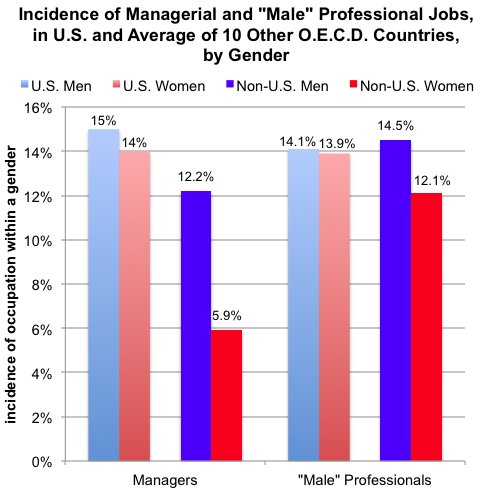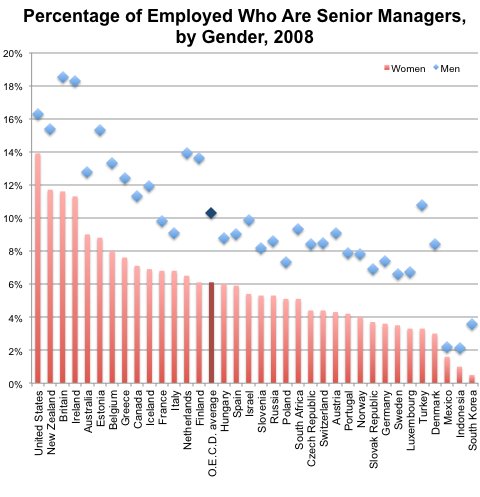One of the more surprising things I learned in my research for an article in The New York Times Magazine is that despite all the complaints about the glass ceiling, the United States is actually doing a relatively good job of getting women into high-achieving jobs.

CATHERINE RAMPELL
Dollars to doughnuts.
Other developed countries have much more family-friendly labor policies than the United States does. The United States is one of only a handful of countries in the world (rich or poor) that do not offer paid maternity leave, for example. And while prominent American companies like Yahoo and Best Buy are banning work-from-home arrangements, European Union countries have legislated that parents can request part-time, flexible or telecommuting arrangements without penalty. In some countries, employers are not allowed to say no to these requests, and in places where they can, there’s often a pretty involved process required to justify the refusal. Some places, like Germany and Spain, also require companies to keep a job open for an employee on parental leave for as long as three years.
A new paper by Francine Blau and Lawrence Kahn of Cornell argues that those policy differences may explain why the United States has fallen behind in women’s labor-force participation rates. But the paper also suggests that the same policy gap could explain why, paradoxically, women in the United States seem to have more varied and ambitious career paths open to them if and when they do choose to work.
After all, not all full-time positions can be easily divided into two or more part-time ones, or can be done remotely. It can be costly or even impossible for employers to reconfigure their existing jobs. Nurses and receptionists can work shifts without difficulty; that’s probably less true for a lawyer on a big merger, where there’s a lot of case-specific knowledge that’s hard to hand off. If women are disproportionately the ones taking advantage of these work-life-balance options — which they are — that makes women more expensive to hire.
The chart below includes data from the study (to be published in The American Economic Review), and shows the share of women and the share of men who were managers or were in traditionally “male” professions (defined as all professionals excluding nurses and pre-university teachers) in the United States versus the average of 10 other developed countries. The numbers are for 2009.
 Source: Francine Blau and Lawrence Kahn, using 2009 International Social Survey Programme microdata. “Male” professionals are professionals excluding nurses and pre-university teachers. Non-U.S. countries are Australia, Austria, Denmark, France, New Zealand, Norway, Portugal, Spain, Sweden and Switzerland.
Source: Francine Blau and Lawrence Kahn, using 2009 International Social Survey Programme microdata. “Male” professionals are professionals excluding nurses and pre-university teachers. Non-U.S. countries are Australia, Austria, Denmark, France, New Zealand, Norway, Portugal, Spain, Sweden and Switzerland.
The lighter-colored bars refer to the incidence of being a manager or traditionally male professional in the United States; the darker-colored bars refer to the same rates for 10 other developed countries. As you can see, American women are about as likely as American men to become managers or land in traditionally male jobs.
To clarify, this does not mean that the United States has as many women as men who are senior managers or professionals, since there are fewer women than men in the overall labor force. It just means that if you’re a working woman, your chances of being a manager or a professional are about as good as they are for a working man.
Indeed, according to separate data from the Organization for Economic Cooperation and Development, the United States has the smallest gap between the share of employed women who are in senior management positions and the share of employed men in such positions.
 Source: Organization for Economic Cooperation and Development. “Senior managers” refers to legislators, senior officials and managers.
Source: Organization for Economic Cooperation and Development. “Senior managers” refers to legislators, senior officials and managers.
In the United States, the ratio of the share of women who are in senior management positions to the share of men who are in senior management positions is about 0.85 (13.9/16.3), whereas for all O.E.C.D. countries it is about 0.59 (6.1/10.3). The country with the next highest ratio, behind the United States, is New Zealand, with a ratio of 0.76 (11.7/15.4).
Article source: http://economix.blogs.nytimes.com/2013/04/02/comparing-the-worlds-glass-ceilings/?partner=rss&emc=rss